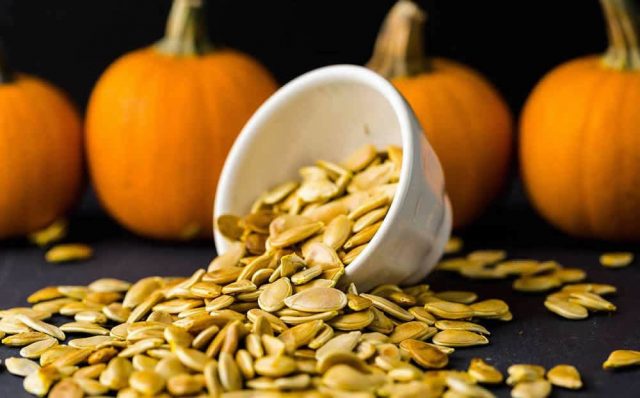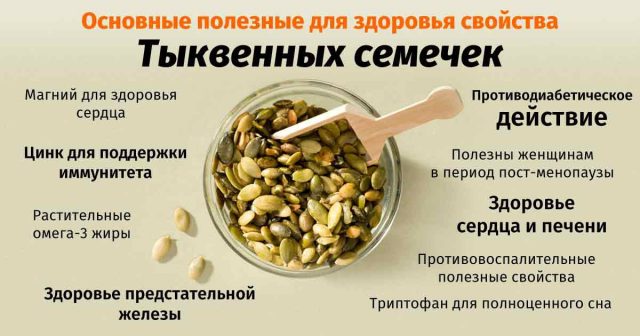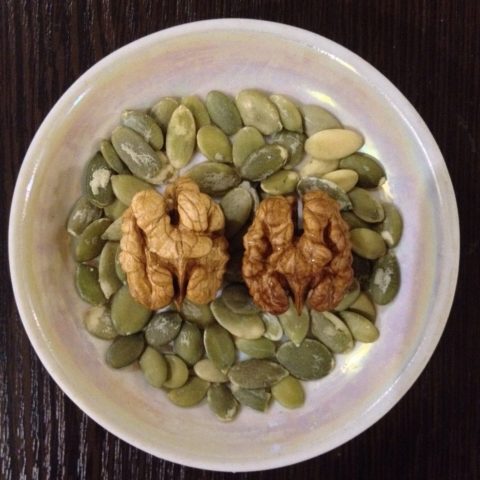Content
Pumpkin seeds for breastfeeding (breastfeeding) can be an excellent source of essential nutrients for mother and baby, if used correctly. There are strict guidelines for how much, when, and in what form you can consume the seeds so as not to cause harm. You should be aware that a simple, familiar product has some contraindications for taking with hepatitis B.
Is it possible for a nursing mother to pumpkin seeds
The lactation period is the time when special attention is paid to the diet. Many common foods are prohibited or restricted with HS because of the fear of harming the child. Although recently doctors are no longer as categorical as before, but the selection of products is quite strict.
The female body's need for nutrients with hepatitis B increases significantly. To maintain full lactation, food must be both light and very healthy, and in a situation of limited choice, this can be difficult to ensure. Therefore, pumpkin seeds, as a natural concentrate of nutrients, minerals, vitamins, light fats, are especially welcomed by doctors.
When used correctly, the seeds are able not only to support the woman's body with useful components, but also to solve the problems of restoring the reproductive system and the whole body after childbirth.
Why pumpkin seeds are useful for mom and baby
The GV period requires a large consumption of nutrients from the mother's body, which pass into milk and are necessary for the baby for full development. Pumpkin seeds provide their intake without burdening digestion, without posing a threat to the health of the child.
The value of pumpkin seeds for HS is determined by their chemical composition:
- 60 g of peeled pumpkin seeds contain a daily supply of magnesium, a substance that provides the body with energy. In particular, therefore, pumpkin seeds during breastfeeding can only be eaten in dosage. The element is responsible for the nutrition of the muscles (primarily the myocardium), the smooth operation of the gastrointestinal tract, and bone density.
- A significant concentration of zinc activates the immune processes in the body of the mother and child. A sufficient intake of this valuable element during hepatitis B provides a stable weight gain in the infant.
- The presence of essential fatty acids, in particular Omega-3 and Omega-6, allows you to saturate the mother's body with healthy, light fats that replenish lipid loss through milk production.
- The complex of active substances in pumpkin seeds is able to gently balance the sugar level, reduce the amount of "bad" cholesterol, and normalize blood pressure.
- Pumpkin seeds are rich in tryptophan, which is a precursor to serotonin (the hormone of joy) and melatonin (responsible for sleep). Thus, pumpkin seeds can be considered a prevention of postpartum depression and a remedy for recuperation.
- The anthelmintic effect of raw pumpkin seeds is widely known. With hepatitis B, they are an effective and safe way to avoid parasite infestation.
When feeding a baby, pumpkin seeds provide breast milk with sufficient fat content, vitamin and mineral composition. For the mother, seeds are valuable for their ability to regulate hormonal levels, increase hemoglobin, and restore reproductive organs from the stress they have suffered in connection with pregnancy and childbirth.
Rules for taking pumpkin seeds for a nursing mother
The creation of a complete diet for women during hepatitis B is aimed at the health and development of the child. Nursing mothers can introduce pumpkin seeds into the diet gradually, starting with 5-6 pcs. per day with the obligatory tracking of any unusual reactions in the infant for 48 hours. If there are no manifestations from the skin, intestines, stool changes, the dose can be gradually increased.
The first intake of pumpkin seeds should take place no earlier than 2 months after childbirth. Previously, the infant's gastrointestinal tract was unable to cope with changes in the composition of breast milk due to immaturity of functions.
In what form can you eat
Pumpkin seeds with HS can be eaten only by observing a safe rate. The beneficial effect on the body becomes noticeable already from 2 tbsp. l. (about 30 g) per day. The maximum number of pumpkin seeds with HB per day, called by doctors, is 80 g. The daily use of a useful natural product is limited for several reasons:
- The calorie content of pumpkin seeds is about 540 kcal per 100 g of refined raw materials. This forces the dosage of the product intake to correct the weight during hepatitis B.
- Roasted seeds stimulate milk production, but exceeding the daily allowance can provoke hyperlactation, stagnation and mastitis.
- To obtain the required amount of some minerals in the composition of pumpkin seeds, it is enough to take 50 g of them per day. An overdose of trace elements from plant materials is hardly possible, but women during the HS period often take multivitamins, which requires dose adjustment.
Doctors advise taking pumpkin seeds 60 g per day for no longer than a month. After that, take a break for a week and continue using the seeds. It is also convenient for GW the reception scheme every other day, then you will not have to take breaks.
Raw
For the health of a woman and a child on HB, the safest and most useful way is to independently harvest pumpkin seeds. To do this, it is enough to remove the seeds from the vegetable, separate them from the fibers, rinse and dry.
Spread the pumpkin seeds on a cloth or gauze. If you need exactly raw seeds, you should not heat them for drying. Purchased seeds must be washed in warm water and dried before use.
Fried
There are several ways to thermally treat pumpkin seeds for use with HS:
- in a pan without oil and salt - 30 minutes;
- in the oven at 180 ° C - 20 minutes;
- in the microwave - no more than 5 minutes.
Pumpkin seeds for use during breastfeeding are fried without seasoning, salt or sweeteners.
Blend to increase lactation
To enhance the production of breast milk, preheated seeds are traditionally used. The nuts for the composition can also be slightly calcined.
Recipe for the remedy:
- Seeds and nuts are taken in equal parts and ground to a state of fine crumbs.
- Pour the mixture with boiled milk cooled to 60 ° C.
- The ratio of nut mass to milk is maintained as 1: 3.
- Insist on the remedy for at least 5 hours.
Take a semi-liquid composition to increase lactation should be 1 tbsp. l. three times a day. In the absence of contraindications, the recipe can be sweetened to taste.
With honey
After the child reaches the age of 4 months, a nursing mother can use a mixture of pumpkin seeds with honey. Raw seeds, peeled off, are pre-ground in a coffee grinder. Mix the product at the rate of 1 tbsp. l. seeds for 2 tbsp. l. honey.Store the mixture in the refrigerator and take a tablespoon a day.
How to choose
Store-bought, packaged pumpkin seeds can be treated with special preparations during production to increase the shelf life. If possible, you should harvest the seeds yourself.
Rules for the selection and preparation of seeds for a diet with HS:
- You should not purchase peeled pumpkin seeds. Raw materials may have been contaminated or contaminated during cleaning and packaging. A product without a protective shell deteriorates faster and can also be treated with chemicals for preservation.
- Salted pumpkin seeds, used for HS, can provoke fluid retention in the body, which leads to edema.
- Store-bought seeds with sugar, caramel, honey contain additional anti-caking and flavoring ingredients that can affect milk quality.
- Purchased pumpkin seeds must be washed in warm water and dried in a hot oven for at least 5 minutes.
Limitations and contraindications
Side effects from taking pumpkin seeds are most often seen from excessive consumption. The child and mother may experience bloating, flatulence, constipation, colic (in a baby).
When breastfeeding, pumpkin seeds can have an undesirable effect on a newborn, regardless of the reaction of the woman's body. So, allergies and problems with the gastrointestinal tract can manifest themselves in a child in the absence of symptoms in the mother. In such cases, the intake of seeds is stopped. Treat symptoms as needed.
A significant excess of the recommended doses for HS can provoke the following conditions:
- upset stomach due to high oil content;
- dehydration due to a diuretic effect;
- lowering blood pressure (critical in case of maternal hypotension).
Conclusion
Pumpkin seeds for HS are an affordable and very useful way to get substances that are useful not only for the mother, but also for the baby. Following simple rules of intake will ensure that the seeds will only benefit.











